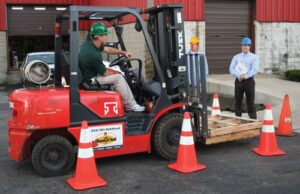May
Tips for Effective Forklift Operator Safety Training and Evaluation
Forklifts play a pivotal role in the efficient movement of heavy materials within manufacturing facilities. However, their operation demands a high level of skill and awareness to mitigate potential safety hazards. Effective training and evaluation of forklift operators are paramount to ensuring a secure working environment for all personnel involved.
Understanding OSHA Requirements
The Occupational Safety and Health Administration (OSHA) mandates strict guidelines for forklift operations. Compliance with these regulations not only ensures a safe workplace but also avoids potential legal liabilities. OSHA requires forklift operators to undergo formal instruction, practical training, and periodic evaluations to assess their competence and adherence to safety protocols.
Structured Training Curriculum
A structured training regimen should cover a range of essential topics, providing trainees with the necessary expertise for safe forklift operation. This includes:
- Equipment Inspection: Trainees learn how to conduct detailed pre-operational inspections of forklifts, identifying any potential mechanical issues or safety hazards. This involves examining brakes, steering mechanisms, tires, lighting systems, and other critical components to ensure optimal performance.
- Safe Handling Practices: Proper techniques for loading, unloading, and transporting materials are emphasized to minimize the risk of accidents or injuries. Trainees are taught about load positioning, stability principles, and the correct operation of attachments such as forks and clamps.
- Hazard Recognition: Trainees are trained to recognize and mitigate common workplace hazards such as uneven surfaces, overhead obstacles, pedestrian traffic, and hazardous materials. Understanding these risks is crucial for accident prevention.
- Accident Prevention Strategies: Proactive strategies for accident prevention are incorporated into the curriculum, promoting a safety-conscious mindset among operators. This includes adhering to speed limits, maintaining visibility, and using defensive driving techniques to anticipate and avoid potential collisions.
Documentation and Evaluation
Thorough documentation is essential for OSHA compliance and continuous improvement. Employers must maintain detailed records of training completion for each forklift operator, specifying the types of powered industrial trucks they are authorized to operate. Utilizing a forklift driver evaluation form allows supervisors to assess trainee performance during practical exercises and proficiency evaluations, providing valuable feedback for ongoing development.
Renewal Training
Regular renewal training is crucial for maintaining the proficiency of forklift operators and ensuring compliance with OSHA regulations. OSHA mandates renewal training and performance evaluation under the following circumstances:
- Accidents and Incidents: In the event of an accident involving a forklift, regardless of severity, renewal training and performance evaluation are required. This ensures that operators receive additional guidance and reinforcement on safety protocols to prevent future incidents.
- Observation of Unsafe Operation: Retraining is necessary anytime a forklift operator is observed operating a forklift in an unsafe manner. Prompt intervention and remedial training help address unsafe practices and mitigate potential risks.
- Changes in Workplace: Operators must receive additional training and evaluation when changes occur in the workplace that could affect safe operation, such as the introduction of new types of powered industrial trucks or modifications to existing equipment. This ensures that operators are familiar with the specific characteristics and operating requirements of the equipment they will be using, reducing the risk of accidents or injuries.
- Every Three Years: OSHA requires renewal training and performance evaluation for forklift operators at least once every three years. This proactive approach ensures that operators’ skills remain up-to-date and aligned with current best practices and regulatory standards.
Who Conducts Evaluations?
According to OSHA’s powered industrial truck standard, forklift training should be conducted by qualified and knowledgeable individuals. Specifically, the standard states that training and evaluation of forklift operators should be performed by persons who have the necessary knowledge, training, and experience to train and evaluate operators safely.
These individuals should possess a thorough understanding of forklift operation principles, relevant safety regulations, and best practices for hazard identification and accident prevention. Additionally, they should be familiar with the specific types of powered industrial trucks used in the workplace and the unique challenges associated with their operation.
Innovation
While adhering to OSHA guidelines forms the backbone of forklift safety training, incorporating innovative approaches can enhance engagement and effectiveness. Here are some out-of-the-box ideas to consider:
- Gamification: Transforming training modules into interactive games fosters active participation and knowledge retention. Gamified elements such as quizzes, challenges, and leaderboards incentivize learning while making the process enjoyable. For example, a forklift obstacle course competition can simulate real-world challenges and encourage healthy competition among operators.
- Peer-to-Peer Mentoring: Pairing experienced forklift operators with novices promotes knowledge sharing and skill transfer. Peer mentors can provide valuable insights, practical tips, and constructive feedback tailored to individual learning styles. This approach not only enhances technical proficiency but also cultivates a culture of teamwork and collaboration within the workforce.
- Scenario-Based Training: Create realistic scenarios that mimic common workplace situations, such as narrow aisles, congested loading docks, or elevated storage areas. By simulating these scenarios during training sessions, operators learn to anticipate challenges, adapt their driving techniques, and make informed decisions under pressure.
Conclusion
Investing in thorough forklift operator safety training and evaluation not only meets regulatory requirements but also safeguards the well-being of employees and protects organizational assets. By embracing innovative training methods and fostering a culture of continuous improvement, supervisors and managers can elevate the standard of forklift safety within their manufacturing operations. Remember, proactive measures today lead to safer tomorrows. Stay vigilant, stay safe!

